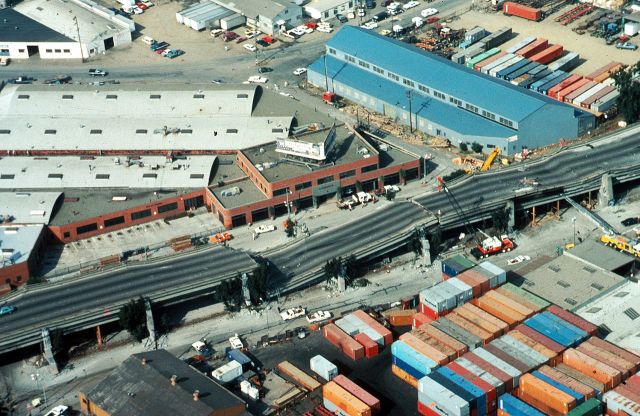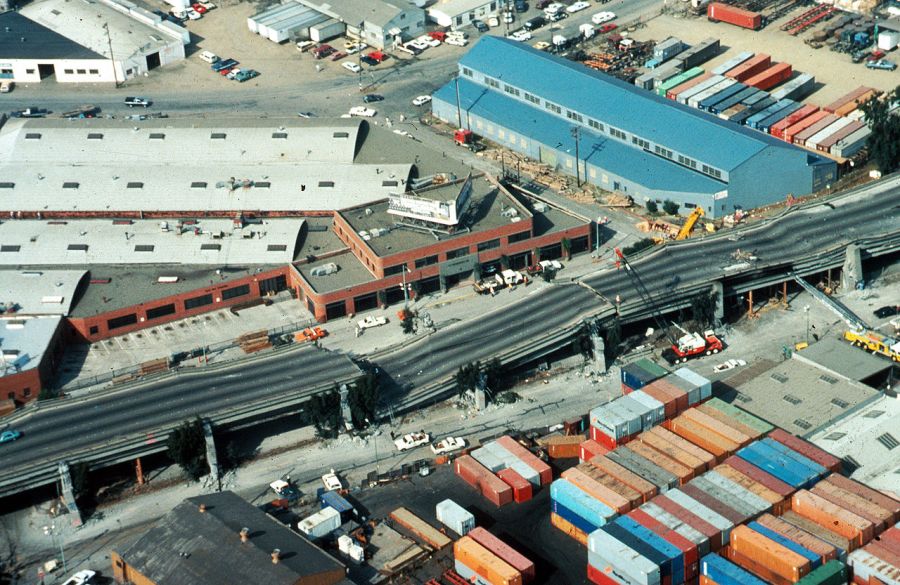SEISMIC FLASHBACK
Life goes on — shakily — in earthquake country
By John M. Leighty
SAN FRANCISCO (UPI) Oct. 18, 1989 — A seismic honeymoon has ended amid deaths, aftershocks and up to $10 billion damage for Californians sharing a beautiful coastal landmass with a slipped and rumbling portion of the treacherous San Andreas Fault.

Life goes on — shakily — for 6.1 million people who live above a network of underground faults in 10 Northern California counties where the last great earthquake of April 18, 1906, left San Francisco shattered and burning.
The slippage of earth that contorted and twisted the Santa Cruz Mountains, halting the third game of the World Series at 5:04 p.m. Oct. 17 and turning a swath of Northern California into a major disaster zone, is still sending ominous daily reminders of the upheaval.

At least 4,000 aftershocks, some four dozen registering above 3.0 magnitude, have followed the major 7.1 magnitude, 15-second-long Loma Prieta earthquake, further endangering homes and buildings already cracked or damaged and jangling the nerves of shaken survivors.
And, scientists say, the Big One is yet to strike — most likely in an area of ‘locked fault line’ a few miles south of San Francisco or along two sections of the Hayward Fault, a 45-mile underground rupture on the populous east side of San Francisco Bay.
The probability of a 7.0 quake within 30 years on one of the three sites — which would be far more destructive because of the urban proximity — has been put at 20 percent by the U.S. Geological Survey.
‘We have had sort of a seismic honeymoon that lasted 60 years or so since the 1906 event,’ said William Ellsworth, a seismologist with the U.S. Geological Survey in Menlo Park, Calif.
‘The terrifying part,’ adds Allan Lindh, another USGS scientist, ‘is that we are underestimating the magnitude that can come out of these fairly short segments. This was one hell of an earthquake.’
In Oakland, where the greatest loss of life occurred when a stretch of a two-tier section of the Nimitz Freeway collapsed, shop owner Owen Maercks of the East Bay Vivarium is trying to find a new location for his snake and lizard shop.
“The earthquake itself didn’t do any damage, but when the freeway fell it was like a Richter scale magnitude of 10 — a much, much bigger shock than the quake itself,” said Maercks. “The shock of the freeway collapse blew cages 15 feet off the shelves and knocked me on my butt. It was a tremendous, apocalyptic thing.”
Maercks, store manager Rebecca Lance, and several employees and customers rushed outside to see mangled cars and concrete, and immediately climbed up on the precarious rubble to rescue trapped motorists.
“When the quake hit, we rushed for the door,”said Lance. “We had a good two or three seconds before the freeway came down in our parking lot. For us, it was the first thing we saw. We had no idea the rest of the city didn’t look the same.
“There were injured people everywhere and cars overturned. It just looked like the end of the world from our vantage point.”
In contrast, at the infamous ‘earthquake trail’ in Olema, Calif., epicenter of the catastrophic shake of 83 years ago, visitors quickly snapped up souvenir seismographic printouts of the quake of ’89 made at the Point Reyes National Seashore, where a few roads buckled but the north Marin County area was otherwise unscathed.
To the south, in scenic Big Sur, the quake was felt but restrained. Pictures fell and power went out for 26 hours, but no major damage was reported.
‘The lights started to dim, I heard a rumble and I said, ‘uh, oh,’ and it started shaking,’ said Big Sur resident Jaci Pappas. ‘You could see the ground rolling and trees swaying. It seemed to last forever.’
The earthquake had unsung heroes — like a fireman who ignored orders to evacuate a collapsing apartment in San Francisco to save a trapped elderly woman — and some that were put into song, like the ‘Ballad of Buck Helm,’ the 57-year-old stevadore miraculously rescued after a 90-hour entombment in the flattened freeway structure.
Trying to return to normal has been easy for some and difficult for others. In such Santa Cruz County towns as Hollister, where downtown areas were flattened, businesses destroyed and thousands of people uprooted and in shelters, the quake’s fury is evident.
In San Francisco, the city reacted swiftly to the emergency, putting practiced earthquake drill procedures into action. Ordinary citizens pitched in, helping firefighters with hoses, directing traffic at blackened intersections, opening their homes to strangers, donating clothes, food and money and volunteering by the thousands at relief shelters.
Boomerbeat Flashbacks by John Leighty can be found on twitter at boomerbeat_views and on the blog The Frisco Beat http://www.friscobeat.com

